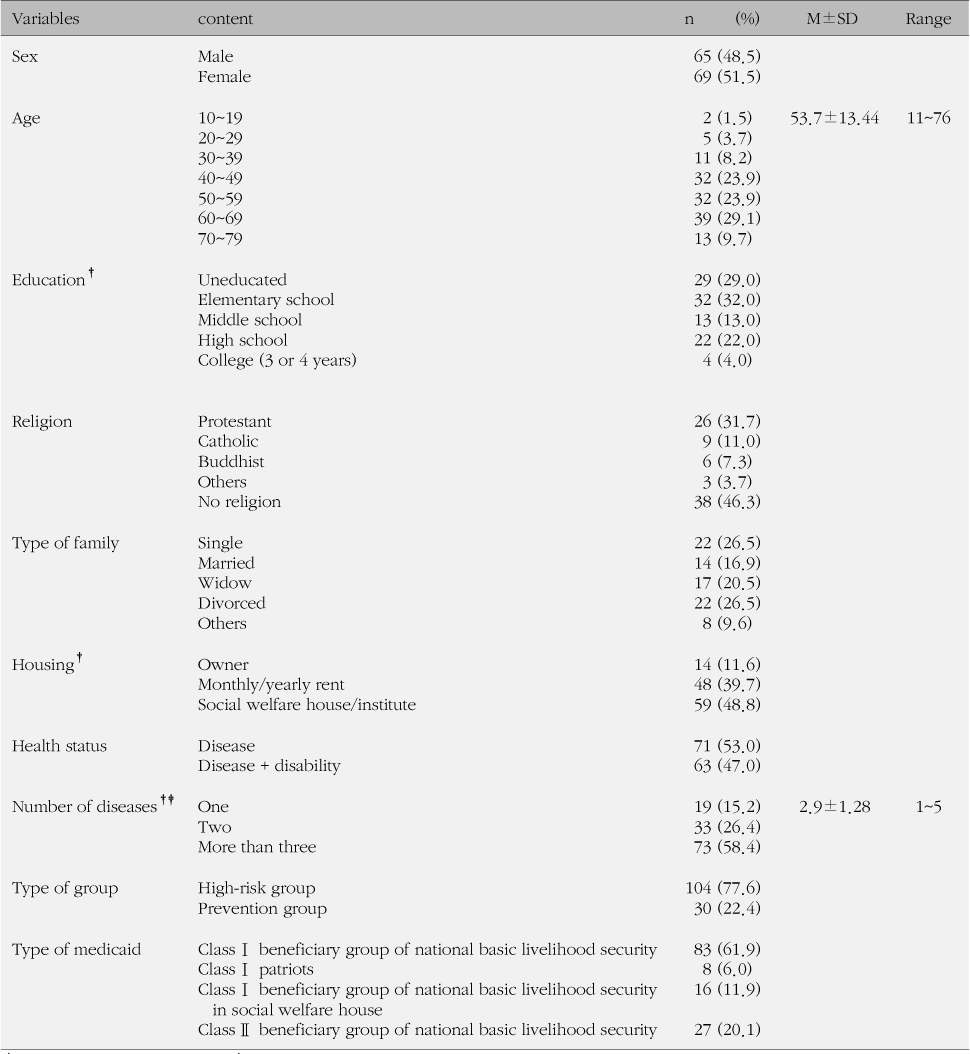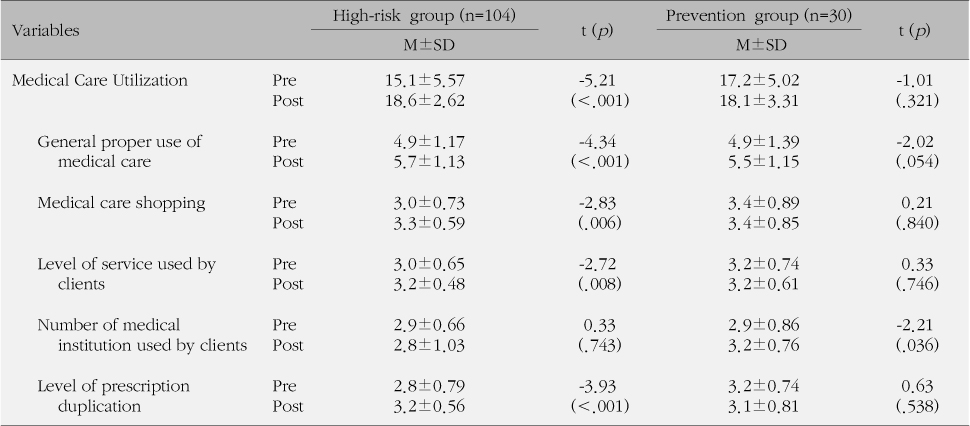References
1. Case Management Society of America. Definition of case management 2002. Retrieved March 28, 2009. from
http://www.cmsa.org.
2. Choi GC, Bae SI, Kim KH, Lee DH. Analysis of innovative outcomes and suggestions on 2007 Medical Aid Program Seoul: National Health Insurance Corporation; 2008.
3. Cohen J. Statistical power analysis for the behavioral sciences New York: Lawrence Erlbaum Associates, Publishers; 1988.
4. Dean K. Self-care components of lifestyles, the importance of gender, attitudes and the social situation. Soc Sci Med 1989;29(2):137–152.
5. Eunpyeong-gu. Year Book of Eonpyeong Statistics Seoul: Eunpyeong-gu; 2009.
6. Han MA, Ryu SY, Park J, Kang MG, Park JG, Kim KS. Health-related quality of life assessment by the EQQol-5D in some rural adults. J Prev Med Public Health 2008;41(3):173–180.
7. Kasl SV, Cobb S. Health behavior, illness behavior and sick role behavior. Arch Environ Health 1966;12:246–266.
8. Kim ES, Lee JR, Yoo WS, Lee YP, Lim SJ, Cho JH, et al. Case management for utilizing reasonable medical service of long-term hospitalized patients among medical aid beneficiaries Seoul: Medical Aid Program Center; 2009.
9. Kim ES, Ahn YH, Ko IS, Lee KO, Ko JS. Planning and development of guide for medical aid case management services Seoul: Ministry of Health, Welfare, and Family Yonsei University · College of Nursing, Institute of Nursing Policy; 2008.
10. Kim ES, Nam JJ, Kim MY, Ko IS, Lee DM, Kim KS, et al. Long-tern medical service use status of medical aid beneficiaries and it's improvements Seoul: Yonsei University College of Nursing, Institute of Nursing Policy; 2007.
11. Kim SM. Utilization changes of hypertension patients according to the medical aid program types Incheon: Gachon University of Medicine and Science; 2009. Unpublished master's thesis.
12. Kim YH. Case management of schizophrenic patients. J Korean Acad Psychiatr Ment Health Nurs 1997;6(2):298–306.
13. Kim HG. Development of case management model for the bed-ridden elderly at home and its evaluation: Focusing on RAI MDS-HC 2.0 application Seoul: Chung-Ang University; 2001. Unpublished doctoral dissertation.
14. Lee IS, Kim SW. The factor influencing behavior of health care of medicaid recipients. Yonsei Soc Welf Rev 2004;11:66–99.
15. Lee IS, Kim DK, Um TY. The study of relationship between self-respect and quality of life and dedication effect of depression among the recipients of the medical security with a chronic disease. Korean J Soc Welf Res 2007;17:79–104.
16. Morales-Asencio JM, Gonzalo-Jimenez E, Martin-Santos FJ, Morilla-Herrera JC, Celdraan-Manas M, Millan Carrasco A, et al. Effectiveness of a nurse-led case management home care model in primary health care: A quasi-experimental, controlled, multi-centre study. BMC Health Serv Res 2008;8:193–206.
17. Ministry of Health, Welfare, and Family. Introduction for medical aid program in 2010 Seoul: Ministry of Health, Welfare, and Family; 2009.
18. Oh JJ. Outcome of a pilot project on case management service for medical aid clients. J Korean Acad Public Health Nurs 2010;24(1):61–70.
19. Onder G, Liperoti R, Solidato M, Carpenter I, Steel K, Bernabei R, et al. Case management and risk of nursing home admission for older adults in home care: Results of the aged and home care study. J Am Geriatr Soc 2007;55:439–444.
20. Park HJ. The factors affecting the mental health of the recipients of the national basic livelihood security Jeonju: Chonbuk National University; 2003. Unpublished master's thesis.
21. Park KA. The related factors on medication adherence in elderly patients with hypertension or diabetes mellitus Daegu: Kyungpookk National University; 2010. Unpublished master's thesis.
22. Rhee WH. Developing a case management strategies program for Korean medical aid clients Seoul: Hanyang University; 2006. Unpublished doctoral dissertation.
23. Riegel B, Carlson B, Kopp Z, LePetri B, Glaser D, Unger A. Effect of a standardized nurse case-management telephone intervention on resource use in patients with chronic heart failure. Arch Intern Med 2002;162:705–712.
24. Schraeder C, Fraser CW, Clark I, Long B, Shelton P, Waldschmidt V, et al. Evaluation of a primary care nurse case management intervention for chronically ill community dwelling older people. J Clin Nurs 2008;17:407–417.
25. Shin EY, Kim CH, Yoo WS, Kim HG, Kim CY. The effect of case management program for diabetic patients in Korean community. J Korean Acad Community Health Nurs 2003;14(4):559–567.
26. Shin HR, Lim SJ, Cho JH. Support and evaluation on case management of medical aid program Seoul: Korea Human Resource Development Institute of Health and Welfare; 2009.
27. Shin YS, Shin HW, Whang DG. Medical aid case management & its effects analysis I Seoul: Korea Institute for Health and Social Affairs; 2007.
28. So AY, Kim YM, Kim EY, Kim CY, Kim CH, Kim HG, et al. Effects of community-based case management program for clients with hypertension. J Korean Acad Nurs 2008;38(6):822–830.
29. Yang SO, Ahn SY, Yim ES, Kwon MS. The effects of customized home visiting health service in Gangwon-do: Focused on hypertension and DM clients. J Korean Acad Community Health Nurs 2008;19(1):88–100.




